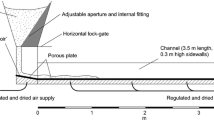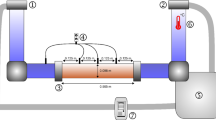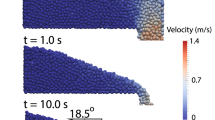Abstract
The ability of a dense pyroclastic flow to maintain high gas pore pressure, and hence low friction, during runout is determined by (1) the strengths and longevities of gas sources, and (2) the ability of the material to retain residual gas once those sources become ineffective. The latter is termed the gas retention capacity. Gas retention capacity in a defluidizing granular material is governed by three timescales: one for the evacuation of bubbles (t be ; brief and not considered in this paper), one for hindered settling from the expanded state (t sett), and one for diffusive release of residual pore pressure from the non-expanded state (t diff). The relative magnitides of t sett and t diff depend on bed thickness, t sett dominating in thin systems and t diff in thick ones. Three pyroclastic flow materials, two ignimbrites and a block-and-ash flow sample, were studied experimentally to investigate expansion behaviour under gas flow and to determine gas retention times. Effects of particle size were evaluated by using two size cuts (<4 mm and <250 μm) from each sample. Careful drying of the materials was necessary to avoid effects of humidity-related cohesion. Two sets of experiments were carried out: (1) expansion in the non-bubbling regime at 50–200°C, (2) bed collapse tests from the initially bubbling state at 50–550°C. Provided that gas channelling was avoided by gentle stirring, all the samples exhibited a regime of uniform expansion prior to the onset of bubbling. Fine particle size (in particular high fines content), low particle density and high temperature all favoured smoother fluidization by increasing the maximum expansion possible in the non-bubbling state. An empirical equation describing the uniform expansion of the materials was determined. High temperature also favoured greater gas partitioning into the dense phase of the bubbling bed, as well (in finer-grained samples) as higher voidage in the settled bed. Large values of t sett and t diff were favoured by fine particle size. Temperature had less influence, suggesting that experimental results at low temperatures (50–200°C) can be extrapolated to higher temperatures. Gas retention times provide insight into the ability of pyroclastic flows in expanded (t sett) or non-expanded (t diff) flow states to retain gas once air ingestion or gas production have become ineffective. Finer-grained pyroclastic flows are expected to retain gas longer, and hence to have higher apparent ‘mobilities’, than coarser-grained ones of comparable volume, as has been observed on Montserrat.















Similar content being viewed by others
References
Abrahamsen AR, Geldart D (1980a) Behaviour of gas-fluidized beds of fine powders. Part I. Homogeneous expansion. Powder Technol 26:35–46
Abrahamsen AR, Geldart D (1980b) Behaviour of gas-fluidized beds of fine powders. Part II. Voidage of the dense phase in bubbling beds. Powder Technol 26:47–55
Botterill JSM, Teoman Y, Yüregir KR (1982) The effect of operating temperature on the velocity of minimum fluidization, bed voidage and general behaviour. Powder Technol 31:101–110
Boudon G, Camus G, Gourgaud A, Lajoie J (1993) The 1984 nuée-ardente deposits of Merapi volcano, Central Java, Indonesia: stratigraphy, textural characteristics, and transport mechanisms. Bull Volcanol 55:327–342
Bruni G, Lettieri P, Newton D, Yates JG (2006) The influence of fines size distribution on the behaviour of gas fluidised beds at high temperature. Powder Technol 163:88–97
Bruni G, Lettieri P, Newton D, Barletta D (2007) An investigation of the effect of the interparticle forces on the fluidization behaviour of fine powders linked with rheological studies. Chem Eng Sci 62:387–396
Calder ES, Cole PD, Dade WB et al (1999) Mobility of pyroclastic flows and surges at the Soufriere Hills Volcano, Montserrat. Geophys Res Lett 26:537–540
Calder ES, Sparks RSJ, Gardeweg MC (2000) Erosion, transport and segregation of pumice and lithic clasts in pyroclastic flows inferred from ignimbrite at Lascar Volcano, Chile. J Volcanol Geotherm Res 104:201–235
Cherntongchai P, Brandani S (2005) A model for the interpretation of the bed collapse experiment. Powder Technol 151:37–43
Ciborowski J, Wlodarski A (1962) On electrostatic effects in fluidised beds. Chem Eng Sci 17:23–32
Cole PD, Calder ES, Sparks RSJ, Clarke AB, Druitt TH, Young SR, Herd RA, Harford CL, Norton GE (2002) Deposits from dome-collapse and fountain-collapse pyroclastic flows at Soufrière Hills Volcano, Montserrat. Geol Soc Lond Memoir 21:231–263
Davies DK, Quearry MW, Bonis SB (1978) Glowing avalanches from the 1974 eruption of the volcano Fuego, Guatemala. Geol Soc Am Bull 89:369–384
Druitt TH (1998) Pyroclastic density currents. Geol Society London Spec Publ 145:145–182
Druitt TH, Calder ES, Cole PD, Norton GE, Ritchie LJ, Sparks RSJ, Voight B (2002) Small-volume, highly mobile pyroclastic flows formed by rapid sedimentation from pyroclastic surges at Soufrière Hills Volcano, Montserrat: an important volcanic hazard. Geol Soc Lond Memoir 21:263–281
Druitt TH, Bruni G, Lettieri P, Yates JG (2004) The fluidization behaviour of ignimbrite at high temperature and with mechanical agitation. Geophys Res Lett 31 L02604, DOI 10.1029/2003GL018593
Fan L-S, Zhu C (1998) Principles of gas-solid flows. Cambridge University Press, p 557
Folk RL, Ward WC (1957) Brazos River bar, a study in the significance of grain-size parameters. J Sediment Petrol 27:3–26
Formisani B, Girimonte R, Mancuso L (1998) Analysis of the fluidization process of particle beds at high temperature. Chem Eng Sci 53:951–961
Foscolo PU, Gibilaro LG (1984) A fully predictive criterion for the transition between particulate and aggregate fluidization. Chem Eng Sci 39:1667–1675
Freundt A, Bursik M (2001) Pyroclastic flow transport mechanisms. In: Freundt A, Rosi M (eds) From magma to tephra. Elsevier, pp 173–245
Geldart D (1973) Types of gas fluidization. Powder Technol 7:285–292
Geldart D, Wong ACY (1985) Fluidization of powders showing degrees of cohesiveness—II. Experiments on rates of de-aeration. Chem Eng Sci 40:653–661
Girolami L, Druitt TH, Khrabrykh Z, Roche O, Kelfoun K (2006) Propagation of experimental pyroclastic flows. Amer Geophys Union, 87(52), Eos Trans, H53D-0656
Hoblitt RP (1986) Observations of the eruptions of July 22 and August 7, 1980, at Mount St. Helens, Washington. US Geol Surv Prof Paper 1335, p 44
Lettieri P, Newton D, Yates JG (1999) Experimental observations of fluidized beds at high temperatures. Eurasian Chem Technol J 1:9–16
Lettieri P, Yates J, Newton D (2000) The influence of interparticle forces on the fluidization behaviour of some industrial materials at high temperature. Powder Technol 110:117–127
Lettieri P, Newton D, Yates JG (2002) Homogeneous bed expansion of FCC catalysts, influence of temperature on the parameters of the Richardson–Zaki equation. Powder Technol 123:221–231
Levine AH, Kieffer SW (1991) Hydraulics of the August 7, 1980, pyroclastic flow at Mount St. Helens, Washington. Geology 19:1121–1124
Lorences MJ, Patience GS, Diez FV, Coca J (2003) Fines effects on collapsing fluidized beds. Powder Technol 131:234–240
Lucas A, Arnaldos J, Casal J, Puigjaner L (1986) High temperature incipient fluidization in mono and polydisperse systems. Chem Eng Commun 41:121–132
Murfitt PG, Bransby PL (1980) Deaeration of powders in hoppers. Powder Technol 27:149–162
Murfitt PG, Bransby PL (1982) Pressures in hoppers filled with fine powders. Powder Technol 31:153–174
Nezzal A, Large JF, Guigon P (1998) Fluidisation behaviour of very cohesive powders under mechanical agitation. In: Fluidization VIII, Proceedings of the Eighth Engineering Foundation Conference on Fluidization, May 14–19. Amer Inst Chem Eng, pp 77–82
Park JJ, Park JH Chang IS, Kim SD, Choi CS (1991) A new bed-collapsing technique for measuring the dense phase properties of gas-fluidized beds. Powder Technol 66:249–257
Rapagna S, Foscolo PU, Gibilaro LG (1994) The influence of temperature on the quality of gas fluidization. Int J Multiphase Flow 20:305–313
Raso G, D’Amore M, Formisani B, Lignola PG (1992) The influence of temperature on the properties of the particulate phase at incipient fluidization. Powder Technol 72:71–76
Rhodes M (1998) Introduction to particle technology. Wiley, New York, p 320
Richardson JF, Zaki WN (1954) Sedimentation and fluidization: part I. Trans Inst Chem Eng 32:35–52
Roche O, Gilbertson MA, Phillips JC, Sparks RSJ (2004) Experimental study of gas-fluidized granular flows with implications for pyroclastic flow emplacement. J Geophys Res 109 B10201, DOI 10.1029/2003JB002916
Rowley PD, Macleod NS, Kuntz MA, Karplan AM (1985) Proximal bedded deposits related to pyroclastic flows of May 18, 1980, Mount St. Helens, Washington. Geol Soc Amer Bull 96:1373–1383
Sparks RSJ (1976) Particle size variations in ignimbrites and implications for the transport of pyroclastic flows. Sedimentology 23:147–188
Tardos GI, Mazzone D, Pfeffer R, Degani D, Nir A (1985) Unsteady flow of a compressible gas through consolidated porous media. Application to deaeration of hoppers. Powder Technol 41:135–146
Wallis GB (1969) One dimensional two-phase flow. McGraw-Hill, New York, p 408
Wilson CJN (1980) The role of fluidization in the emplacement of pyroclastic flows: an experimental approach. J Volcanol Geotherm Res 8:231–249
Wilson CJN (1984) The role of fluidization in the emplacement of pyroclastic flows, 2: experimental results and their interpretation. J Volcanol Geotherm Res 20:55–84
Wilson L, Head JW (1981) Morphology and rheology of pyroclastic flows and their deposits, and guidelines for future observations. US Geol Surv Prof Paper 1250:513–524
**e H-Y, Geldart D (1995) Fluidization of FCC powders in the bubble-free regime: effects of types of gases and temperature. Powder Technol 82:269–277
Yamamoto T, Takarada S, Suto S (1993) Pyroclastic flows from the 1991 eruption of Unzen Volcano, Japan. Bull Volcanol 55:166–175
Yamazaki R, Han NS, Sun ZF, Jimbo G (1995) Effect of chemisorbed water on bed voidage of high temperature fluidised bed. Powder Technol 84:15–22
Yates JG (1996) Effects of temperature and pressure on gas–solid fluidization. Chem Eng Sci 51:167–205
Yates JG, Newton D (1986) Fine particle effects in a fluidized bed reactor. Chem Eng Sci 41:801
Yu AB, Feng CL, Zou RP, Yang RY (2003) On the relationship between porosity and interparticle forces. Powder Technol 130:70–76
Acknowledgements
We are indebted to John Yates for his enthusiastic support in the early stages of this project and to Olivier Roche for discussions. Colin Wilson and an anonymous reviewer helped improve the manuscript.
Author information
Authors and Affiliations
Corresponding author
Additional information
Editorial responsibility: J. Stix
Appendix
Appendix
Notation
Symbol
- A :
-
surface area of fluidization rig (m−2)
- ɛ :
-
hydrodynamic voidage
- f :
-
drag factor (Pa m−1)
- g :
-
gravitational acceleration (9.82 m−2)
- H :
-
bed thickness (m)
- K :
-
permeability (m−2)
- M :
-
sample mass (kg)
- μ :
-
gas viscosity (Pa s)
- n :
-
exponent in Richardson–Zaki equation
- P :
-
gas pressure (Pa)
- P 0 :
-
initial gas pressure at base of bed (Pa)
- r:
-
gas constant (296.8 J kg−1 K−1 for nitrogen)
- ρ :
-
density of gas or particles (kg m−3)
- t :
-
time (s)
- T:
-
absolute temperature (K)
- u :
-
gas or particle velocity (m s−1)
- U :
-
superficial gas velocity at T of operation (m s−1)
- z :
-
height (m)
Subscript
- atm:
-
atmospheric value
- be:
-
value following bubble evacuation
- diff:
-
pressure diffusion
- g:
-
value for gas phase
- mb:
-
value at minimum bubbling
- mf:
-
value at minimum fluidization
- mp:
-
value at maximum pressure
- s:
-
value for solid phase
- sett:
-
value during or following settling
- t :
-
terminal value
Rights and permissions
About this article
Cite this article
Druitt, T.H., Avard, G., Bruni, G. et al. Gas retention in fine-grained pyroclastic flow materials at high temperatures. Bull Volcanol 69, 881–901 (2007). https://doi.org/10.1007/s00445-007-0116-7
Received:
Accepted:
Published:
Issue Date:
DOI: https://doi.org/10.1007/s00445-007-0116-7




